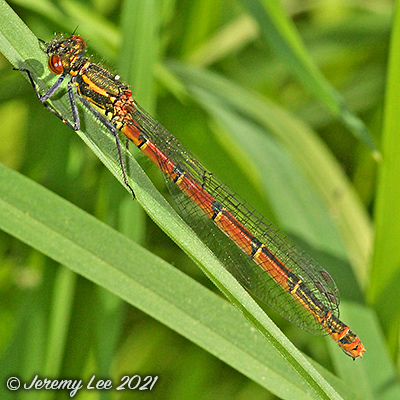
 |
|
Scientific Classifications explained » Amphibians » Ants » Aphids » Bees » Beetles » Birds » Bugs » Butterflies » Caterpillars » Damselflies » Dragonflies » Earwigs » Flies » Frog/Leafhoppers » Fungi » Galls » Grasshoppers » Harvestmen » Hoverflies » Lacewings » Ladybirds » Leaf Mines » Lichens » Mammals » Millipedes » Mosses » Moths » Sawflies » Slugs » Snails » Spiders » Trees » Wasps » Wild Flowers » Woodlice |
UK Nature > Damselflies > Pyrrhosoma nymphula

Scientific Name: Pyrrhosoma nymphula Common Name: Large Red Damselfly Pyrrhosoma nymphula, commonly known as the Large Red Damselfly, is often the earliest dragonfly to appear and is relatively easy to identify being predominantly red and black, with black legs, which distinguish it from the Small Red Damselfly. Measuring roughly 36mm in length, the Large Red Damselfly is a large, active, deep red damselfly with black legs and a bronze-black top to the thorax which has broad red or yellow stripes. The female exists in several colour forms varying in the amount of red and black on the abdomen from nearly all black in f. melanotum to mainly red in f. fulvipes. The pterostigma is black. This is one of the earliest species to appear each spring and can be found in almost any freshwater habitat but rarely on fast-flowing rivers or streams. Widespread and common in Britain and Ireland. |
|

https://www.uknature.co.uk is a website dedicated to showing the immense diversity of UK nature and wildlife. Our vast range of habitats, from lowland arable to snow covered mountains, from storm-ravaged coastlines to peaceful inland freshwater lakes and rivers, from dry, sandy heaths to deciduous and coniferous forests, all these habitats contribute to the abundance of UK nature. We have wild birds in huge numbers either residing or visiting our shores (597 recorded species as at July 2013) and we must also not forget the humble back garden with its grass lawns, flower beds filled with nectar rich flowers, shrubs and trees, all designed to attract huge numbers of insects such as bees, moths, butterflies and hoverflies; and finally the small ponds which provide safe havens for frogs, toads, newts and even slow worms and grass snakes. www.uknature.co.uk is the showcase for my personal passion, photographing uknature in all its glory. I sincerely hope you all enjoy the fruits of my labours. This site and all images contained therein is © Jeremy Lee 2004 - 2021. All Rights Reserved. Site design by Jeremy Lee. Site development & IT Support by Stuart Lee. |